Yet Another Magnificent "Seven"
La-7 in 1/72 by Eduard
|
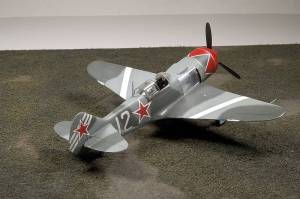 |
Since announcement of their release of this famous Soviet WW2 fighter
I was holding my breath. Earlier iterations of this radial-engine beauty
by KP and Frog were well beyond modern standards and their accuracy was
questionable at best.
Well, those who wait patiently are rewarded and earlier this year Eduard
released three kits in a series of La-7 family: two-gun version, three-gun
version, and profi pack.
As a super-detail addict I had to wait few more months to get my hands
on the profi pack.
Quick glance inside the box made it clear that this kit is from the "must
buy" category judging by the quality of molding and surface details.
Needless to say that all the references were set aside for the work months
before the model arrived.
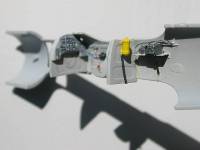 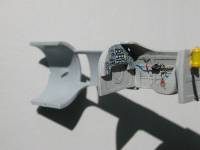 I
am not going to tell you the story of the real thing as it was told before
many times. As of today, excellent sources such as Gordon's and Khazanov's
Soviet Combat Aircraft of the Second World War, Vol.1, Erik Pilavskii's
Soviet Air Force Fighter Colors 1941 - 1945, and Milos Vestsik's Lavochkin
La-7 (listed in alphabetical order) will tell you as much as one will
need for a starter. I
am not going to tell you the story of the real thing as it was told before
many times. As of today, excellent sources such as Gordon's and Khazanov's
Soviet Combat Aircraft of the Second World War, Vol.1, Erik Pilavskii's
Soviet Air Force Fighter Colors 1941 - 1945, and Milos Vestsik's Lavochkin
La-7 (listed in alphabetical order) will tell you as much as one will
need for a starter.
OK, time to get to work, which I usually start from the cockpit.
Cockpit
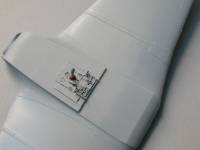 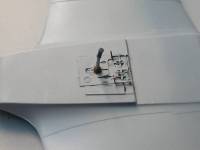 Although
the cockpit in the kit's plastic form is quite basic, it could be greatly
enhanced by the photoetched set included in the profi pack (the same set
is also a part of Eduard's more extensive PE detail set released not long
ago). I was very impressed with the colored PE seat belts, instrument
panel, various handles and piping. Carefully examining photographs of
the cockpit in the reference books I decorated the cockpit (which received
its portion of painting). All started to look much more realistic. The
only problem not addressed by the manufacturer was the space behind the
pilot's seat - just an empty space. Although
the cockpit in the kit's plastic form is quite basic, it could be greatly
enhanced by the photoetched set included in the profi pack (the same set
is also a part of Eduard's more extensive PE detail set released not long
ago). I was very impressed with the colored PE seat belts, instrument
panel, various handles and piping. Carefully examining photographs of
the cockpit in the reference books I decorated the cockpit (which received
its portion of painting). All started to look much more realistic. The
only problem not addressed by the manufacturer was the space behind the
pilot's seat - just an empty space.
It was time to do some scratchbuilding of the radio shelf but I was not
convinced tht it should be of the MiG-3 type. As usual, in the time of
great doubt, friends came to the rescue and supplied me with even more
references of how the radio equipment was arranged (actually, the second
edition of 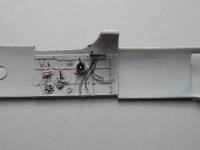 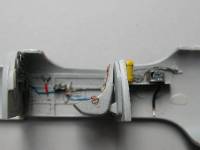 Milos
Vestsik's book has some excellent photos of this area - by that time I
had the first edition of his book - you got the hint, did you?). After
examining these newly revealed evidence of radio equipment arrangement
I decided to spare myself from scratching plastic inserts and resorted
to photoetched parts again. This time the Part PE set for Yak-18 served
me as a source of necessary radio boxes. Adding some wires solved the
problem of making it look realistic enough (when everything is done one
can hardly see what is inside but I know it's there). The cockpit floor
received rudder pedals from the kit's PE set, the cockpit was washed and
various side panels' handles were installed. By the way, Eduard supplied
some extra PE parts (really small ones) in case some of them will disappear
(and they did, of course!). Milos
Vestsik's book has some excellent photos of this area - by that time I
had the first edition of his book - you got the hint, did you?). After
examining these newly revealed evidence of radio equipment arrangement
I decided to spare myself from scratching plastic inserts and resorted
to photoetched parts again. This time the Part PE set for Yak-18 served
me as a source of necessary radio boxes. Adding some wires solved the
problem of making it look realistic enough (when everything is done one
can hardly see what is inside but I know it's there). The cockpit floor
received rudder pedals from the kit's PE set, the cockpit was washed and
various side panels' handles were installed. By the way, Eduard supplied
some extra PE parts (really small ones) in case some of them will disappear
(and they did, of course!).
Fuselage Assembly
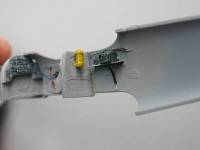 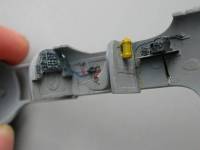 One
of the most prominent details of the fuselage are exhaust pipes and louvres.
Exhausts are given as plastic arcs with some vaguely seen details, which
are supposed to represent pipes. Simple glance on a photograph of this
assembly on a real plane just doesn't allow for the use of the kit parts
(this is much better handled on Eduard's new PE set). I decided to use
something more realistic. At this time the best solution to exhaust pipes
problem is - yes, you guessed it right - Moskit exhausts. But they don't
make them for La-7! I found a solution by scavenging pipes from their
I-153 set. All I needed was just much shorter pieces of the smallest available
diameter, and I-153 set just gives you that. I cut small sections and
pressed them a bit so that they don't look perfectly round or oval but
rather a bit flat. I glued them to the inner sides of the One
of the most prominent details of the fuselage are exhaust pipes and louvres.
Exhausts are given as plastic arcs with some vaguely seen details, which
are supposed to represent pipes. Simple glance on a photograph of this
assembly on a real plane just doesn't allow for the use of the kit parts
(this is much better handled on Eduard's new PE set). I decided to use
something more realistic. At this time the best solution to exhaust pipes
problem is - yes, you guessed it right - Moskit exhausts. But they don't
make them for La-7! I found a solution by scavenging pipes from their
I-153 set. All I needed was just much shorter pieces of the smallest available
diameter, and I-153 set just gives you that. I cut small sections and
pressed them a bit so that they don't look perfectly round or oval but
rather a bit flat. I glued them to the inner sides of the 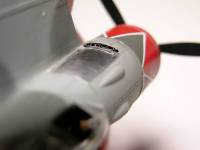  louvres
one by one and it made all the difference in the world! Well, I hope nobody
would count them because there is one pipe short on each side (the pipes
were a bit bigger in diameter after all - Moskit, do you hear me? Exhausts
just for the La-7 would be nice to have). louvres
one by one and it made all the difference in the world! Well, I hope nobody
would count them because there is one pipe short on each side (the pipes
were a bit bigger in diameter after all - Moskit, do you hear me? Exhausts
just for the La-7 would be nice to have).
Than I attached the louvres to the fuselage sides when a small problem
occurred. When the louvres are almost shut the fit is OK, but when they
are open so that the pipes are visible ( a very prominent feature!) there
is a gap between the louvres and the fuselage on the top side of the assembly.
This was easily dealt with by plastic inserts.
I closed the fuselage part after this (adding whatever details from the
tail landing gear necessary).
I carefully fitted gun cover panel and assembled the front cowling with
engine louvres.
Wing and Horizontal Stabilizer
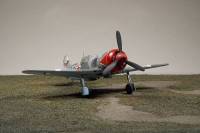 I
assembled wings and attached them to the fuselage. The fit was quite good
and I used very little putty to fill small gaps. The problem arose with
the shape of wingtips - they are a bit too pointed. I used the wings of
KP La-5 kit to make a paper template and used it as a guide for a pencil
line. A few strokes with a file solved this problem for good. I
assembled wings and attached them to the fuselage. The fit was quite good
and I used very little putty to fill small gaps. The problem arose with
the shape of wingtips - they are a bit too pointed. I used the wings of
KP La-5 kit to make a paper template and used it as a guide for a pencil
line. A few strokes with a file solved this problem for good.
I dressed an oil cooler scoop with PE radiator and attached it to the
lower wing.
At this time the model started to look like a real little fighter on the
factory floor.
Canopy and Final Assembly
From the beginning I decided to keep the canopy open to show all the
real estate of the cockpit area. I do prefer vacuum-form canopies as they
look more realistic being more to scale thickness. There are not many
choices available today (aftermarket guys, do you read me?) - just  old
good Falcon. I carefully cut three pieces from their base and dry-fitted
them. To my disappointment they did not fit. At all!. The aft canopy would
just fall through the opening in the fuselage, so I decided to keep the
kit's part in this case. The sliding canopy is quite usable but the front
one did not fit either. I started to consider my options. I could use
the kit's front canopy as well but something did not appeal to me in it's
looks. Checking against the references I verified that the windshield
is too wide and just doesn't look like Lavochkin. An old good La-5FN from
KP offered a more realistic alternative. But as I mentioned, it's Falcon
version did not fit. The solution was easier done than said: I filed off
the "cheeks" around the sitting place for the front canopy and
the replacement almost clicked in place. I filled small gaps and sanded
whatever had to be sanded. Obviously, clear parts received a dip in Future
prior to assembly. I prepared final subassembly details (landing gear
doors and landing gear) and thinned the doors for the tail wheel. Spinner
and propeller were assembled as directed. There was something odd with
the spinner shape and I at first decided to use this part from an old
KP La-7 kit. However I decided to give it a try and after several minutes
of circular motion with a sand paper the kit's spinner changed its shape
in the right direction thus being saved from the spare box. A word on
the prop. Eduard made the best ever VISh-105 propeller in this scale. old
good Falcon. I carefully cut three pieces from their base and dry-fitted
them. To my disappointment they did not fit. At all!. The aft canopy would
just fall through the opening in the fuselage, so I decided to keep the
kit's part in this case. The sliding canopy is quite usable but the front
one did not fit either. I started to consider my options. I could use
the kit's front canopy as well but something did not appeal to me in it's
looks. Checking against the references I verified that the windshield
is too wide and just doesn't look like Lavochkin. An old good La-5FN from
KP offered a more realistic alternative. But as I mentioned, it's Falcon
version did not fit. The solution was easier done than said: I filed off
the "cheeks" around the sitting place for the front canopy and
the replacement almost clicked in place. I filled small gaps and sanded
whatever had to be sanded. Obviously, clear parts received a dip in Future
prior to assembly. I prepared final subassembly details (landing gear
doors and landing gear) and thinned the doors for the tail wheel. Spinner
and propeller were assembled as directed. There was something odd with
the spinner shape and I at first decided to use this part from an old
KP La-7 kit. However I decided to give it a try and after several minutes
of circular motion with a sand paper the kit's spinner changed its shape
in the right direction thus being saved from the spare box. A word on
the prop. Eduard made the best ever VISh-105 propeller in this scale.
Painting and Markings
It was tough to decide what aircraft I would choose to represent. I
wanted something colorful but not what everybody else was doing. I saw
the box art of Gavia 1/48 cousin and liked it a lot. However, with no
photographic evidence of the real thing I was very skeptical of their
offering.
 As
I said before, good things come to those who are patient (not always my
virtueJ). A photograph of Kosolapov's La-7 circulated on Russian discussion
forum and soon appeared in the second edition of Milos Vestsik's La-7
book. That was IT! No doubts in my mind, I will finish my model in these
markings! It's time to mention that Major Kosolapov was a commander of
937 IAP of 322 IAD. The photograph was taken In Prague in May 1945. As
I said before, good things come to those who are patient (not always my
virtueJ). A photograph of Kosolapov's La-7 circulated on Russian discussion
forum and soon appeared in the second edition of Milos Vestsik's La-7
book. That was IT! No doubts in my mind, I will finish my model in these
markings! It's time to mention that Major Kosolapov was a commander of
937 IAP of 322 IAD. The photograph was taken In Prague in May 1945.
The model was painted blue underside and AMT-11 grey on the top. Than
I applied the spots of AMT-12 dark-grey paint in appropriate areas (except
of the nose).
The most interesting part started with the nose decoration. As we all
know, red paint will look differently over different underplaying coats.
I certainly did not want red color to be too light over light-grey surface
and too dark over dark-grey one. I decided to use a uniform light-grey
color in the nose area for this purpose. I masked everything except the
very front of the nose where the decoration is solid. This part was sprayed
red and the masking tape was removed. After thorough drying I masked the
rest of the nose in order to spray top and bottom parts of it, repeating
the process several days later for the left and right sides. Everything
went as planned to my delight. Than I reversed the process and masked
red areas to apply dark-grey color between red segments. Now you can calculate
how many days it took considering at least one day of drying time for
each iteration.
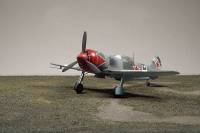 I
decided to paint white stripes on the wings, while the tale decoration
to be accomplished with decals. I
decided to paint white stripes on the wings, while the tale decoration
to be accomplished with decals.
Everything painted and dry, I applied Future and made a subtle wash to
accentuate panel lines where appropriate.
Decals came next. The stars from the kit's decal sheet were a bit too
orange to my eye and I decided to use an aftermarket offering from Eagle
Strike Production, set 72074 Russian National Insignia WW2. The color
of Eduard's decals was not the only (and main) reason for my choice: the
fuselage star on Kosolapov's machine is much bigger than the one in the
kit offering. Decals went on without any problems. The nose was further
decorated with white outlines of the red "tulip" and silver
decals representing harnesses of the cowling. I also added some paint
chipping, which was supplied by Eduard in decal form (excellent move!).
The model received a flat coat after which I removed masking tape from
the canopy glazing (my favorite part). I attached the landing gear and
their doors. The wheels are given in two variants: ready to go and with
the disks molded separately. This is an excellent idea and makes painting
much easier. However, I decided to use Equipage wheels for LaGG-3 model.
I dressed the landing gear with PE details.
I decided to use Bare Metal Foil ® for exhaust side panels. The only
problem with that was how to apply exhaust stains on their surface. I
did not want to cover them with flat coat - it kills this metallic look
and feel. It took several weeks to figure it out. I used very fine black
powder, which sticks 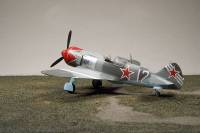 very
well (unlike the pastel chalk). I did not try CMK's new weathering powders;
they might do the job as well. I am not at liberty to reveal the secret
of my solution (I gave my word to 3Guyz company, our local club guys who
found it and kindly offered me to test it). very
well (unlike the pastel chalk). I did not try CMK's new weathering powders;
they might do the job as well. I am not at liberty to reveal the secret
of my solution (I gave my word to 3Guyz company, our local club guys who
found it and kindly offered me to test it).
Everything was almost ready, just few final touches with antenna wire
and Pitot tube to finalize the process. I made Pitot tube from fine tubing
and used the plastic base of it from the kit.
When I took a few test shots of the model and shared it with my friend
Alex Ruchkovski (he is famous for his very sharp eye and no less sharp
criticism if something is not right) and he pointed me to the fact that
the model just doesn't sit right, looking a bit too Fw-190-eish. I looked
at the photographs one more time and realized that Alex was absolutely
right. If one assembles landing gear doors to the legs as is suggested
by the assembly pins, the result would be like what I got. It wasn't an
easy decision but I had to do it: I removed the landing gear and shortened
them a bit (look at the photos in your references to find this point).
Correspondingly, I had to cut landing gear doors as well. The struts had
to go as well and I decided to make them from metal tubing.
When landing gear was redone it looked as La-7 should be looking - mighty
fighter of the Victory.
Conclusions
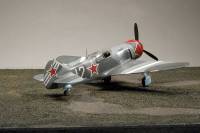 I
enjoyed every minute of work on this little gem. The few bugs did not
detract me from its strong points and high quality. These small errors
are easily correctable although there is some suspicion that the wing
chord is not where it should be. I
enjoyed every minute of work on this little gem. The few bugs did not
detract me from its strong points and high quality. These small errors
are easily correctable although there is some suspicion that the wing
chord is not where it should be.
Details are excellent and crisp, PE parts saved the day with the cockpit
interior (and I did not have to wait for them another half a year).
Eduard did a great job to give us a very nice model of this prominent
fighter-plane as well as left some room for improvements to modelers with
AMS (advanced modelers syndrome).
I just hope Eduard will not stop on the La-7 kit and will seriously consider
the La-5 family for their nearest future plans.
I also hope that Aires or CMK will produce a detail set for this model
with cockpit details and motor and gun bays. This model is just crying
for things like that!
Highly recommended for modelers of all levels.
I would like to thank Eduard for
providing the kit for review.
Acknowledgements
My thanks are extended to:
1. Terry Higgins of Skygrid for review sample
2. Matt Bittner for the review kit direct from Eduard
3. Alex Ruchkovski for invaluable advice and additional references
4. Aleks Sekularac for expert advice on photographing my model
5. 3 Guys and Dave Shwab for the secret black powder to replicate exhaust
stains
|
|
